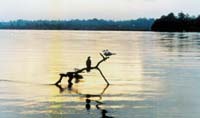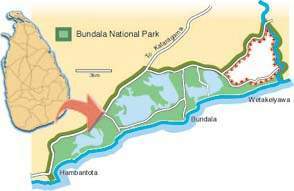Shrinking
Bundala
We
are near a tiny, natural pool, trying to capture the beauty
of flocks of herons, spoonbills, egrets, elegant painted storks
and the occasional ibis. It is late April and the flamingos
- the main attraction of this wonderful birds' paradise, have
flown back home to India.
|
Importance
of Bundala
Bundala was declared a sanctuary in 1969 and upgraded
to a national park in 1992.
In 1990, under the Convention on Wetlands of International
Importance for Migratory Waterfowl, Bundala was declared
a Ramsar site, the only one in this country. In Scots'
Directory of Asian wetlands, Bundala is the 26th recognised
site.
To
be so recognised, the area has to be an example of a
wetland type rare or unusual, support an appreciable
assemblage of rare, vulnerable and endangered species
or subspecies or plant or animal or an appreciable number
of individuals. It also should have special value for
maintaining the genetic and ecological diversity and
regularly support 20,000 waterfowl.
Bundala
is a haven for migrant and resident birds, and is home
to over 20,000 migrant birds. According to 'A Guide
to Bundala' by Channa Bambaradeniya, a total number
of 383 plant species are found while 324 species of
vertebrates are also found, 11 being endemic while 29
are nationally threatened species. The largest reptiles
in Sri Lanka, crocodiles and the Indian python and highly
venomous species such as the cobra, Russell's viper
and the saw -scaled viper are found in Bundala.
Importantly,
Bundala is an ideal habitat for birds, both resident
and migratory. This bird paradise is also a haven for
waders with a total of 197 residents and 58 winter visitors
being recorded within the park during the past three
years. Among the residents, three are endemic while
10 are nationally threatened.
|
As we
draw nearer, the birds get disturbed and leave their little
pool. And it is yet another wonderful sight to watch the painted
storks in flight, their black, pink and white feathers drawing
a distinct pattern against the clear blue sky.
A little
beyond the pool, I spot the peafowl, spreading its plumage
as the sun comes out. There are also the small wonders like
the green-feathered bee-eaters and the kingfishers. Diverse
and beautiful. But all these charms may be transitory, as
the Bundala national park, home to so many resident and migratory
birds and also the habitat of the globally endangered waterfowl,
stands threatened today.
A move
by the government to redraw the boundaries thereby significantly
reducing the land area of the Bundala national park, the only
recognised Ramsar wetland in Sri Lanka and undisputedly, the
country's most recognised bird site has alarmed environmentalists.
The 6216
ha park area consists mainly of dry thorny scrubland and lagoons.
In addition, there are streams, seasonal water holes, tanks,
salt marshes, mangroves, seashores and salterns, aspects that
add to the diversity of habitat and the richness of its biodiversity.

The shallow
brackish water lagoons within the park include Koholankala
( 390 ha), Malala (650 ha), Embilikale ( 430 ha) and Bundala
( 520 ha) creating a complex wetland system which provides
for the rich and diverse bird life. Three streams, Malala,
Embilikele and Kirindi Oya also flow through the park area.
The southern
border of the park, a haven for peacocks, migrant birds and
crocodiles is the area under threat. According to senior officers
of the Department of Wildlife Conservation, the plan to issue
title deeds to the villagers of Wetakeiyawa and Bundala has
been in the pipeline for a decade.
Long before
Bundala was declared a national park in1992, these villagers
occupied the land and farmed there. The plan to grant title
deeds to these villagers would in effect reduce the land extent
at least by a vital 1200 ha, according to officials.
Mostly
farmers, the villagers of Wetakeiyawa and Bundala occasionally
do some inland fishing when the economy plummets. Their families
have lived in the same area for at least three generations.
But, things changed when the area was declared a natural reserve,
and Bundala was declared a national park ten years ago, they
said.
"Nobody
disrupts our cultivations. But we do feel restricted because
there are so many park rules that we have to adhere to now.
Removing firewood, cutting a tree for a fence are things that
we can no longer do. The park brings revenue to the government,
but not to us," said A. Nandasena, a farmer.
Other
villagers too seem to agree with Nandasena's sentiments that
their lifestyle has been affected as a result of the park.
They have no other land to plough, so they cultivate parkland.
Some felt
they should have been granted land many years ago, and were
taken by surprise when two years ago, officials visited the
area to assess the land and the extent of cultivation with
a view to re-declaring park boundaries excluding the two villages.
"We
thought it was perfectly legal for us to cultivate the land
and believed we had absolute ownership. Two years ago, we
requested title deeds or a viable alternative," said
another villager.
But with
the move to re-declare the park boundaries earning the ire
of environmentalists, the new government is reconsidering
its options.
Minister
of Environment and Natural Resources Rukman Senanayake told
The Sunday Times that the ministry was willing to consider
new options that would be fair by the people and support habitat
conservation.
"The
re-declaration of Bundala boundaries is an emotional issue
for environmentalists and ecologists. It should be so, considering
the significance of the site. We appreciate the need to protect
out wetlands as they maintain the ecological balance. At the
same time, we invite fresh suggestions that could settle the
problem in a satisfactory manner," he told The Sunday
Times.
He added
that he would initiate discussions with the villagers so that
a solution could be found, based on their requirements. There
has been no proper structural management of the park so far,
and there were many aspects that needed to be immediately
addressed besides the villagers' issue.
Environmental
lawyer Jagath Gunawardene said that perhaps the best solution
would be to resettle people under the Kirindi Oya scheme or
in the Bandagiriya area, a nearby village that is recommended
for farming activities. As a third option, he said that land
could be granted from other areas depending on the choice
of villagers in a manner conducive to their livelihood. "It
is much better to resettle them elsewhere.
That way,
they could gain more arable land and the freedom to do their
farming without the park rules restricting them. Similarly,
the park would be protected from possible plundering, poaching
and illegal felling," he said.
Endorsing
the above view, a former Samurdhi officer from Bandagiriya,
K. Somasiri said that the villagers were not insisting that
they should live in Wetakeiyawa or Bundala. Their main concern
was to cultivate land, and they would actually prefer a scheme
which would grant them title deeds of more land.
He noted
that much destruction was being caused to the vegetation as
the residual agro chemicals that are discharged to the lagoon
have an adverse effect on aquatic animals.
Environmentalists
also claim that as elephants migrate to Uda Walawe between
Koholangala and Malala, the route should be kept free of cultivation
or settlements to prevent elephant- man conflicts.
Environmentalists
also point out the many other threats to Bundala such as shell
mining, poaching, hunting and felling of trees causing the
depletion of the vital forest canopy in an arid area.
Minister
Senanayake added that there have been complaints about high
speed driving within the park area that could destroy the
habitat. The park was also severely affected by the recent
drought with waterholes drying up and many animals dying.
|